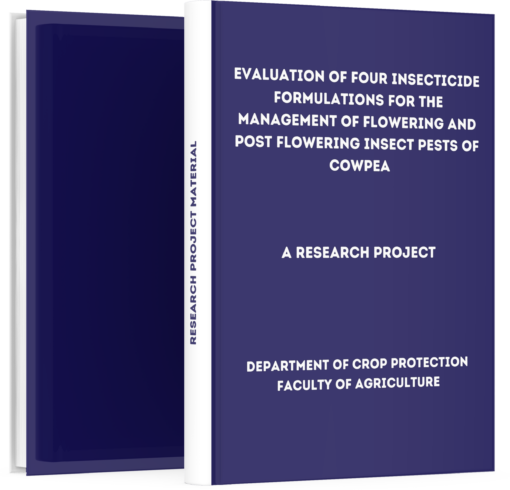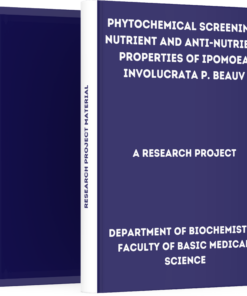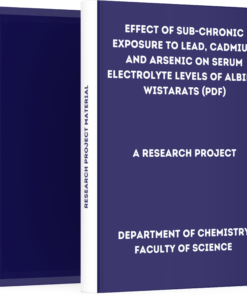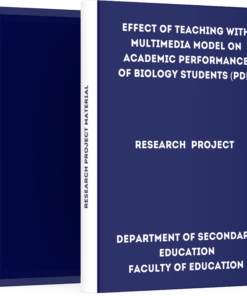Evaluation of Four Insecticide Formulations for the Management of Flowering and Post Flowering Insect Pests of Cowpea
₦3,000.00
If you are interested in getting this project material “Evaluation of Four Insecticide Formulations for the Management of Flowering and Post Flowering Insect Pests of Cowpea”, click on the DOWNLOAD BUTTON to make payment and the file will be delivered to your email immediately after confirmation.
Description
Download Evaluation of Four Insecticide Formulations for the Management of Flowering and Post Flowering Insect Pests of Cowpea. Crop Protection students who are writing their projects can get this material to aid their research work.
Abstract
Field trials on evaluation of four insecticide formulations for the management of flowering and post flowering insect pests of cowpea were conducted in two locations (IAR Research Farm Samaru, Zaria, Kaduna State (Lat.11o 111N and 7o 381N) and Wase.
In Minjibir local government of Kano State (Lat. 12 100 60.001 and 8 400 0.001 E), under rainfed conditions in the Northern Guinea Savannah and Sudan Savannah of Nigeria respectively. Four insecticide formulations: Chlorpyrifos, Chlorpyrifos plus, Dimethoate and Imidacloprid. There was a standard check (Cyperdicot; 250+30 g a.i./ha) and an untreated control.
The treatments were arranged in a randomized complete block design (RCBD) replicated three times. Population of thrips, Megalurothrips sjostedti Tryb, Maruca. Vitrata and Clavigralla. Tomentosicollis were sampled 24 hours before and after each spray for three weeks between 7.00 and 8.00am.
The damage was assessed by counting the number of aborted flowers/plot; seed damage indices (Sdi) was determined by sorting the seed lot from each plot into 3 categories. The results showed that all the four insecticides effectively reduced the population and infestation of insect pests as well as increased the yields compared to untreated control.
Most of the insecticides differ significantly from the standard check (Cyperdicot). The various levels (concentrations) 0.5, 1.0 and 1.5 l/ha were similar in their performance in reducing insects’ population and infestation, pod and seed damage.
Introduction
Cowpea (Vigna unguiculata (L.) Walp.) Is an important grain legume in the tropics and subtropics. It is native to central Africa and belongs to the family Fabaceae (Cobley, 1956). Cowpea is eaten in the form of grain, green pods, and leaves (Adejumo, 1997).
The roots are eaten in Sudan and Ethiopia, and the peduncles and stems are used as source of fibres in Nigeria (Adejumo, 1997). Cowpea is known as vegetable meat due to high amount of protein in the grain with better biological value on dry weight basis (Owolabi et al., 2012).
Cowpea grain depending on varieties, for instance, IAR 48 (SAMPEA 7) contains 26.61 % protein, 3.99 % lipid, 56.24 % carbohydrates, 8.60 % moisture, 3.84 % ash, 1.38 % crude fibre, 1.51 % gross energy, and 54.85 % nitrogen free extract (Owolabi et al., 2012).
Cowpea is mainly grown in tropical and sub tropical regions of the world for vegetable and grain and to a lesser extent as fodder crop. It is a very versatile pulse crop because of its smothering nature, drought tolerant character, soil restoring properties and multi-purpose uses.
More than 11 million hectares are cultivated worldwide, 97 % of which is in Africa. Nigeria alone cultivates 4.5 million hectares annually representing over 60 % of total production (FAO STAT, 2011). The crop can be harvested in three stages; while the pods are young and green, mature and green and dry.
It is mostly grown as an intercrop with sorghum, maize and millet (Asiwe, 2007; Voster et al., 2007). Cowpea is usually preferred by farmers because of its role in increasing soil fertility through nitrogen fixation and production of nutritious fodder for livestock (Blade et al., 1997 and Asiwe et al., 2009).
How to Download this Project Material
First, note that we are one of the best and most reliable online platforms because we don’t retain any of your personal information or data as regards making payments online.
PRICE: ₦3,500 ₦3,000 (Three Thousand Naira Only)
Make a bank deposit or mobile transfer of ₦2,000 only to the account given below;
Bank Name: UBA Account Number: 1022564031 Account Name: TMLT PRO SERVICES
After making the payment, CLICK HERE to send the following on WhatsApp;
- Depositor’s Name or Screenshot of Payment
- Name of the Past Question
- Active Email Address
or Call Us On +2348082284439 Once your details have been received and your payment confirmed by us, you will receive the past question in your email or WhatsApp within 5 Minutes.
Guarantee of Getting the Material
We understand that due to the high rate of fraud, many people are afraid of making purchases online but be rest assured that PastExamQuestions will deliver your material after payment.
Once your details have been received and your payment confirmed by us, you will receive the past question in your email or WhatsApp.
Give us Feedback
Have we been able to satisfy you? How well do you think the material will be helpful after having gone through it? Does the price worth the material?
Let’s hear from you! We recommend that our customers give feedback at the end of every transaction to enable us to serve better. You can do this by clicking the review button on this page.
Where is the review button? >> Just scroll up to where you see reviews





Reviews
There are no reviews yet.